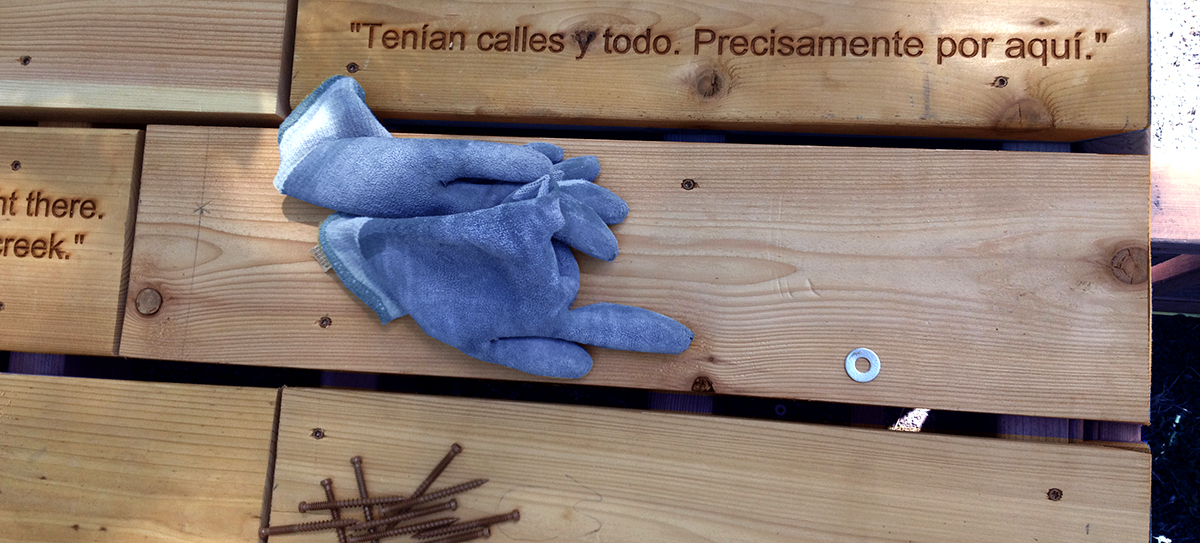
EXPANDING the FIELD
Summer 2013 | Public Interest Design Studio | Austin, Texas
Public Interest Design Seminar: Nicole Joslin
Project Team: Casey-Marie Claude, John Cunningham, Kelly Denker, Brian Gaudio, Anna Katsios, Gordon Lee, Matthew Martinec, Marianne Nepsund, Nathaniel Schneider, Daniel Sebaldt, and Allison Stoos
Over the summer semester twenty-two students participated in the UTSOA Public Interest designbuild Studio. Central to the PID/DB approach, students work closely with local organizations that included the City of Austin Parks and Recreation Department, the Rosewood Neighborhood Association, a group of neighborhood kids from M Station Learning Center, and several elderly residents from a senior center who grew up in Rosewood neighborhood. These organizations contributed their time and energy to help shape the studio’s design + build work along the Boggy Creek Greenbelt in East Austin. There students worked on two distinct projects meant to raise environmental stewardship awareness while directly addressing a few of the ongoing ecological concerns East Austin residents have faced for decades. Half of the PID/DB students worked on this project in Boggy Creek Park while the other half developed a work about a mile to the north at the MLK light rail stop (see Portal).
The project is sited near Boggy Creek where Austin’s Watershed Department is currently expanding the riparian zone along the creek to provide greater habitat for wildlife, while helping to cleanse water runoff finding its way to the creek. Until the 1970s, the Boggy Creek floodplain—now Boggy Creek Park—frequently flooded into the adjoining neighborhoods where people of color had been relocated in the 1920s. To exacerbate this problem, the area had been used as one of Austin’s garbage dumps until the time people began living there. As a way to remedy these deplorable conditions, the City acquired the floodplain area in the seventies and converted the land into a string of greenbelt parks complete with hike and bike trails, pavilions, and open parkland with mature oak, cottonwood, and pecan trees.
Students chose to work on three distinct projects in Boggy Creek Park which are in close proximity to creek. Part of their work involved coordination with City of Austin Watershed Department. Students were fortunate that an ecologist with Watersheds was a member of the Rosewood Neighborhood Association and founding member of Friends of Boggy Creek, a local neighborhood volunteer group that helped maintain the park. Each of the three projects had a specific theme addressing watershed conditions. The first design focused on the riparian zone bordering both sides of the creek. Three students who designed and built this work provided seating facing the riparian zone where one can watch wildlife while learning more about native plant and animal species through a series of laser-cut images that line the screen walls of the pavilion.
A second nearby pavilion, designed and built by another three students, focused on the tree canopy overhead, which provides a welcome refuge of cool shade in summer. While the sidewalls of this structure are sheathed in 2x cedar screening, it is open overhead so that views are directed upward to the live oak canopy above. Sloped seating achieving these upward views is seamlessly incorporated into the angular structure. Quotes and poems from students at M Station are laser-cut into the seating describing how they like use the park.
The third pavilion further down the creek sits adjacent to The Conley-Guerrero Senior Activity Center. This project sits close to the creek area where it changes from a more natural stream with riparian edges to one that has been channelized. Built by five students, this pavilion addresses the human intervention that radically changed the creek, an obvious reference to the channelization. But it also addresses the former residents who until the seventies lived where the students’ work is now constructed. In that regard, this project speaks to the a time in the 1920’s when Austin families of color were forced to move from West Austin to the East Side. And later when the City razed their homes situated in the floodplain to turn the area into a park. Students interviewed a number of the elderly who regularly visit the Senior Activity Center and found several who had lived in the now-demolished homes along the Boggy Creek. A number of quotes about their experiences are laser-cut into this structure.